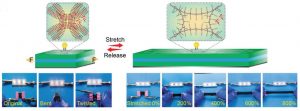With the emergence of flexible and wearable electronics, stretchable supercapacitor power sources are in high demand due to their superior mechanical flexibility and energy storage capacity. In previous studies, the misalignment or displacement of device multi-layers could not be completely avoided due to inefficient structural designs and processing methods, which resulted in unsatisfactory performance and limited stretchability.

A schematic illustration of the real‐time healing mechanism of the device during the charge–discharge process.
In addition, current stretchable devices are far from “smart” as there is great difficulty in simultaneously integrating both stretchable and smart elements into one device without sacrificing its supercapacitor performance. Real-time self-healing is vital to the durability of the device due to regular and unavoidable microstructural fractures caused by local stress during the charge-discharge processes.
To address these challenges, a team led by Huai-Ping Cong at Hefei University of Technology in collaboration with Shu-Hong Yu’s group at the University of Science and Technology of China reported the construction of a highly stretchable, multiresponsive supercapacitor. The device was rationally designed, including the microstructures of electrode and electrolyte, interfacial interactions among current collector, electrode, and electrolyte, and all-in-one device configuration with the assistance of dynamic metal-thiolate coordination chemistry.
The assembled supercapacitor device with integrated configuration delivered a large areal capacitance of 885 mF/cm2, superhigh stretching strain of 800% (see figure), and rapid optical self-healing capabilities. Unique real-time electrical self-healing during the charge-discharge process was also demonstrated for the first time.
These prominent performance advantages outcompete previously reported supercapacitors. The design concept presented in this work can be extended to other stretchable and self-healing energy-storage devices, providing a platform for the development of future flexible, wearable electronic devices.

















